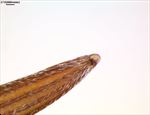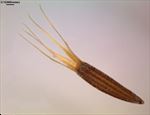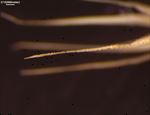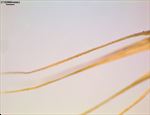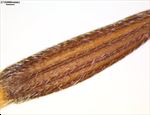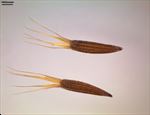Taxonomy
Elephantopus scaber L., Sp. Pl. 2:814. 1753Common synonyms
Elephantopus carolinensis G.Mey.; Elephantopus plurisetus (O.Hoffm.) Clonts; Elephantopus scaber L.; Elephantopus scaber subsp. oblanceolata Kitam.; Elephantopus scaber subsp. oblanceolata-oblonga Kitamura; Elephantopus scaber subsp. oblanceolato-oblonga Kitam.; Elephantopus scaber subsp. plurisetus (O.Hoffm.) Philipson; Elephantopus scaber subsp. scaber; Elephantopus scaber var. albiflorus Kuntze; Elephantopus scaber var. angustatus J.Kost.; Elephantopus scaber var. argenteus C.Jeffrey; Elephantopus scaber var. brevisetus Philipson; Elephantopus scaber var. hirsutus Philipson; Elephantopus scaber var. liniatus Miq.; Elephantopus scaber var. plurisetus O.Hoffm.; Elephantopus scaber var. scaber; Elephantopus scaber var. serratus J.Kost.; Elephantopus scaber var. sinuatus (Mor.) Miq.; Elephantopus scaber var. typicus J.Kost.; Elephantopus sinuatus Zoll. & Moritzi; Elephantopus sordidus Salisb.; Elytropappus glandulosus var. microphyllus; Elytropappus muricella Steud.; Elytropappus muricella Steud. ex Sch.Bip.; Elytropappus scaber (L.f.) Druce; Elytropappus scaber (L.f.) Kuntze; Elytropappus scaber (L.f.) Levyns; Myrovernix scaber (L.f.) Koek.; Rhagadiolus scaber (L.) All.; Scabiosa cochinchinensis Lour.; Stoebe scabra L.f.Common name
Elephant foot
Description
Propagule or dispersal unit is the fruit with pappus. Fertile part 3-4.7 mm long, 0.6-1.1 mm wide, in side view widest in upper part (obovoid), +/- straight, the upper (apical) end narrowing, rarely suddenly cut off (truncate), in cross-section round (terete) or flattened, basal scar (carpopodium) pronounced and well-differentiated, off to the side (oblique) or at least asymmetric, rarely central, beak (=thinner sterile stalk between seed and pappus) absent, wings absent, fruit surface light brown or straw, smooth (except at cellular level), with no hairs (glabrous), simple straight hairs or glands or glandular hairs, thickened margin absent, longitudinal ribs present, 8-10, their surfaces smooth, with simple straight hairs.
Pappus type bristles / hairs or scales, pappus elements all +/- similar, up to 4-5.5 mm long, in one row, number of pappus elements c. five to six, persistent, the individual bristles rough / serrated (barbellate), clearly wider at base, brown, rarely white / translucent, the individual scales triangular to acute.
Ecology
Annual to perennial herb, seeds wind-dispersed. Subtropical and tropical regions. Used in herbal medicine. Found in forest margins, open forests and woodlands, grasslands, and as a weed of disturbed places.
Native range
Tropical Africa, southern, southeastern and eastern Asia, northern Australia.
